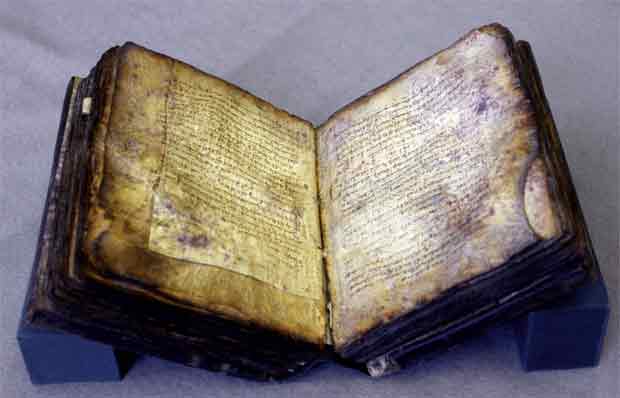
Word of the Day: Palimpsest
I’ve been away for a while now, but I’m back with a new word.
A palimpsest is, according to Mirriam Webster, “writing material (such as a parchment or tablet) used one or more times after earlier writing has been erased,” or, more broadly, “something having usually diverse layers or aspects apparent beneath the surface.” Further, according to Mirriam Webster,
Long ago, writing surfaces were so rare that they were often used more than once. Palimpsest originally described an early form of recycling in which an old document was erased to make room for a new one when parchment ran short. (The word is from the Greek palimpsēstos, meaning “scraped again.”) Fortunately for modern scholars, the erasing process wasn’t completely effective, so the original could often be distinguished under the newer writing. De republica, by Roman statesman and orator Cicero, is one of many documents thus recovered from a palimpsest.
According to www.etymonline, the word is from the “1660s, from Latin palimpsestus, from Greek palimpsestos ‘scraped again,’ from palin ‘again, back’ (from PIE *kwle-i-, suffixed form of root *kwel- (1) ‘revolve, move round’ (IE *kw- becomes Greek p- before some vowels) + verbal adjective of psen ‘to rub smooth,’ which is of uncertain origin.”
It’s kind of hard to imagine today, but in ages past, people didn’t recycle paper by putting it into the recycle bin. They also did not throw away parchment because it was really expensive. So they would take a document and strip off the old ink, which frequently soaked into the parchment (think of writing on paper with a magic marker and how the ink even goes through). They basically used soapy water (an alkaline solution) and then scrubbed the parchment (made from the skin of sheep or goats so less likely to tear when wet) with a pumice stone (a light, porous stone formed by volcanic glass). Then they could write on the parchment again. Interestingly, with forensic technology, we are sometimes able to determine what the original document said.
In 1906, Johan Heiberg, the world’s leading scholar on the Greek mathematician Archimedes at that time, published seven works by Archimedes that the world had thought was lost. The codex was originally copied in the 10th century. Archimedes explained his ideas about mathematics in letters to friends and colleagues, and in the sixth century, Isidorus of Miletus compiled into a complete work. In the 10th century, an anonymous scribe made a copy of Isidorus’s compilation. Sometime after that, perhaps after 1204, the codex found its way to Jerusalem, and then in 1229, the codex was unbound, scraped and cleaned, and used, along with parchment from other documents that had received the same treatment, to create a liturgical book. This liturgical book was made of 177 folded pages, of which 174 are extant. But the monks who scraped and cleaned the pages did not do a very good job, at least not be modern standards, a failing for which scholars are grateful.
Then, in 1840, a Biblical scholar found this liturgical work in Constantinople and took a page home to the Cambridge University library. This led to a Greek scholar’s cataloging of the various pieces of the codex, which led to Heiberg’s recognizing the authorship of Archimedes and the deciphering of the underlying texts.
There are other examples of palimpsests, many of them old copies of the Gospels or other Biblical texts. It is a fascinating area of study.
However, I recently came across a form of the word using its broader definition, “something having usually diverse layers or aspects apparent beneath the surface.” I’m reading a collection of essays called The Inklings and King Arthur: J. R. R. Tolkien, Charles Williams, C. S. Lewis, and Owen Barfield on the Matter of Britain, edited by Sørina Higgins. In her opening, introductory chapter, she writes,
I begin in chapter 1, “The Matter of Logres: Arthuriana and the Inklings,” by defining terms and providing an overview of the adaptability of cultural appropriations of Arthur throughout his palimpsestuous history.
Now, if you look in your dictionary for the word palimpsestuous, you won’t find it. It’s what we call a portmanteau word, a coinage of Lewis Carroll in 1871. It’s two words (and ideas) blended into one word (linguists refer to this kind of word as a blend). Higgins’s blend is really good.
And there really isn’t anything more to say.